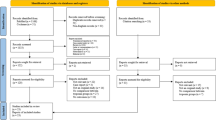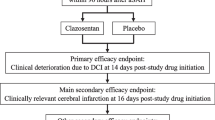Abstract
Cystatin C (CysC) has been found to be associated with hemorrhagic and ischemic stroke in many studies. However, the association between CysC level and the risk of delayed cerebral ischemia after endovascular treatment of aneurysmal subarachnoid hemorrhage has been reported rarely. Our study was proposed to explore this association. Consecutive patients from June 2015 to February 2021 in this single-center retrospective study were selected. Univariate and multivariate analyses were used to identify potential prognostic risk factors for delayed cerebral ischemia, and the stability of the association was demonstrated by several statistical methods, such as subgroup analysis, interaction testing, generalized linear models, and propensity score matching. A total of 424 patients were included in the analysis. Cystatin C was independently associated with delayed cerebral ischemia. The independent effects of CysC on delayed cerebral ischemia were shown in generalized linear models with a logit link, and the results were relatively stable in crude, partial, and full models with ORs (95% CIs) for delayed cerebral ischemia. Subgroup analysis showed no significant subgroup differences in the effect of CysC on delayed cerebral ischemia. There was also no interaction effect between CysC and other confounders. Patients in the high CysC group had a higher risk of delayed cerebral ischemia than those in the low CysC group before and after propensity score matching. CysC level could be an independent predictor for the risk of delayed cerebral ischemia after endovascular treatment of aneurysmal subarachnoid hemorrhage.



Similar content being viewed by others
Data availability
After providing a reasonable request, all supporting data for this study are available from the corresponding author.
Code availability
Not applicable.
References
Feigin VL, Lawes CMM, Bennett DA, Barker-Collo SL, Parag V (2009) Worldwide stroke incidence and early case fatality reported in 56 population-based studies: a systematic review. The Lancet Neurology 8:355–369
Dorhout Mees SM, Kerr RS, Rinkel GJE, Algra A, Molyneux AJ (2012) Occurrence and impact of delayed cerebral ischemia after coiling and after clip** in the International Subarachnoid Aneurysm Trial (ISAT). J Neurol 259:679–683
Roos YB, de Haan RJ, Beenen LF, Groen RJ, Albrecht KW, Vermeulen M (2000) Complications and outcome in patients with aneurysmal subarachnoid haemorrhage: a prospective hospital based cohort study in the Netherlands. J Neurol Neurosurg Psychiatry 68:337–341
Lu VM, Graffeo CS, Perry A et al (2020) Rebleeding drives poor outcome in aneurysmal subarachnoid hemorrhage independent of delayed cerebral ischemia: a propensity-score matched cohort study. J Neurosurg 133(2):360–368
van Gijn J, Rinkel GJ (2001) Subarachnoid haemorrhage: diagnosis, causes and management. Brain J neurology 124:249–278
Macdonald RL, Schweizer TA (2017) Spontaneous subarachnoid haemorrhage. Lancet 389:655–666
Samuels OB, Sadan O, Feng C et al (2021) Aneurysmal subarachnoid hemorrhage: trends, outcomes, and predictions from a 15-year perspective of a single neurocritical care unit. Neurosurgery 88:574–583
Kelly DM, Ademi Z, Doehner W et al (2021) Chronic kidney disease and cerebrovascular disease: consensus and guidance from a KDIGO Controversies Conference. Stroke 52:e328–e346
Laterza OF, Price CP, Scott MG (2002) Cystatin C: an improved estimator of glomerular filtration rate? Clin Chem 48:699–707
Dong X, Nao J (2019) Cystatin C as an index of acute cerebral infraction recurrence: one-year follow-up study. Int J Neurosci 129:36–41
Maldaner N, Steinsiepe VK, Goldberg J et al (2020) Patterns of care for ruptured aneurysms of the middle cerebral artery: analysis of a Swiss national database (Swiss SOS). J Neurosurg 133(6):1811–1820
Wang Y, Li W, Yang J et al (2019) Association between cystatin C and the risk of ischemic stroke: a systematic review and meta-analysis. J Mol Neurosci MN 69:444–449
**ao D, Liu H, Zhang H, Luo Y (2012) Impact of cystatin C levels on infarct size and hemorrhage volume in acute cerebral stroke. J Neurol 259:2053–2059
Chang Z, Zou H, **e Z et al (2021) Cystatin C is a potential predictor of unfavorable outcomes for cerebral ischemia with intravenous tissue plasminogen activator treatment: a multicenter prospective nested case-control study. Eur J Neurol 28:1265–1274
Frontera JA, Fernandez A, Schmidt JM et al (2009) Defining vasospasm after subarachnoid hemorrhage: what is the most clinically relevant definition? Stroke 40:1963–1968
Vergouwen MDI, Vermeulen M, van Gijn J et al (2010) Definition of delayed cerebral ischemia after aneurysmal subarachnoid hemorrhage as an outcome event in clinical trials and observational studies: proposal of a multidisciplinary research group. Stroke 41:2391–2395
Suzuki H, Shiba M, Nakatsuka Y, Nakano F, Nishikawa H (2017) Higher Cerebrospinal Fluid pH may Contribute to the Development of Delayed Cerebral Ischemia after Aneurysmal Subarachnoid Hemorrhage. Transl Stroke Res 8:165–173
Dengler NF, Sommerfeld J, Diesing D, Vajkoczy P, Wolf S (2018) Prediction of cerebral infarction and patient outcome in aneurysmal subarachnoid hemorrhage: comparison of new and established radiographic, clinical and combined scores. Eur J Neurol 25:111–119
Fang YJ, Mei SH, Lu JN et al (2019) New risk score of the early period after spontaneous subarachnoid hemorrhage: for the prediction of delayed cerebral ischemia. CNS Neurosci Ther 25:1173–1181
Platz J, Güresir E, Wagner M, Seifert V, Konczalla J (2017) Increased risk of delayed cerebral ischemia in subarachnoid hemorrhage patients with additional intracerebral hematoma. J Neurosurg 126:504–510
Wu Y, He Q, Wei Y et al (2019) The association of neutrophil-to-lymphocyte ratio and delayed cerebral ischemia in patients with aneurysmal subarachnoid hemorrhage: possible involvement of cerebral blood perfusion. Neuropsychiatr Dis Treat 15:1001–1007
Kim JA, Rosenthal ES, Biswal S et al (2017) Epileptiform abnormalities predict delayed cerebral ischemia in subarachnoid hemorrhage. Clin Neurophysiol 128:1091–1099
Leijenaar JF, Dorhout Mees SM, Algra A, van den Bergh WM, Rinkel GJE. Effect of magnesium treatment and glucose levels on delayed cerebral ischemia in patients with subarachnoid hemorrhage: a substudy of the Magnesium in Aneurysmal Subarachnoid Haemorrhage trial (MASH-II). International journal of stroke : official journal of the International Stroke Society 2015;10 Suppl A100:108–12.
Olsson T, Nygren J, Håkansson K et al (2004) Gene deletion of cystatin C aggravates brain damage following focal ischemia but mitigates the neuronal injury after global ischemia in the mouse. Neurosci 128:65–71
Dorhout Mees SM, Molyneux AJ, Kerr RS, Algra A, Rinkel GJE (2012) Timing of aneurysm treatment after subarachnoid hemorrhage: relationship with delayed cerebral ischemia and poor outcome. Stroke 43:2126–2129
Goertz L, Pflaeging M, Hamisch C et al (2020) Delayed hospital admission of patients with aneurysmal subarachnoid hemorrhage: clinical presentation, treatment strategies, and outcome. J Neurosurg 134:1182–1189
Ni L, Lü J, Hou LB et al (2007) Cystatin C, associated with hemorrhagic and ischemic stroke, is a strong predictor of the risk of cardiovascular events and death in Chinese. Stroke 38:3287–3288
Goksu E, Goksu E, Karsli B et al (2014) Cerebrospinal fluid cystatin C levels following treatment for aneurysmal subarachnoid hemorrhage. Turk Neurosurg 24:391–397
Loew M, Hoffmann MM, Koenig W, Brenner H, Rothenbacher D (2005) Genotype and plasma concentration of cystatin C in patients with coronary heart disease and risk for secondary cardiovascular events. Arterioscler Thromb Vasc Biol 25:1470–1474
Su MX, Zhou Y, Chen ZL et al (2022) Cystatin C predicts futile recanalization in patientswith acute ischemic stroke after endovascular treatment. J Neurol 269(2):966–972
Liu Y, Cai H, Wang Z et al (2013) Induction of autophagy by cystatin C: a potential mechanism for prevention of cerebral vasospasm after experimental subarachnoid hemorrhage. Eur J Med Res 18:21
Funding
This study was supported by the Special Fund for Science and Technology of Guangdong Province (grant number: [2020]53–50) and the Dengfeng Project for the construction of high-level hospitals in Guangdong Province, The First Affiliated Hospital of Shantou University Medical College Supporting Funding.
Author information
Authors and Affiliations
Contributions
Conception and design: Kehua Chen. Acquisition of data: Kehua Chen, Guanghua Huang, Chengwei Cai, Chuangnan Yan, Fuguang Zhang. Statistical analysis: Kehua Chen, Min Yao. Interpretation of data: Kehua Chen, Hongwu Xu. Drafting the article: Kehua Chen. Critically revising the article: Thanana Nuchkrua, Junqiang Ma, Hongwu Xu. Reviewed and approved the submitted version of manuscript: all authors.
Corresponding authors
Ethics declarations
Ethics approval
This study has obtained the approval from the institutional review board (grant number: B-2021–231).
Consent to participate
After approval from the institutional review board, informed consent was waived in this retrospective study.
Consent for publication
The consent to publish this manuscript has been received from all participants.
Conflict of interest
The authors declare no competing interests.
Additional information
Publisher's Note
Springer Nature remains neutral with regard to jurisdictional claims in published maps and institutional affiliations.
Supplementary Information
Below is the link to the electronic supplementary material.
Rights and permissions
About this article
Cite this article
Chen, K., Huang, G., Cai, C. et al. Higher cystatin C level increases the risk of delayed cerebral ischemia after endovascular treatment of aneurysmal subarachnoid hemorrhage: a case–control study. Neurosurg Rev 45, 2407–2415 (2022). https://doi.org/10.1007/s10143-022-01765-9
Received:
Revised:
Accepted:
Published:
Issue Date:
DOI: https://doi.org/10.1007/s10143-022-01765-9




